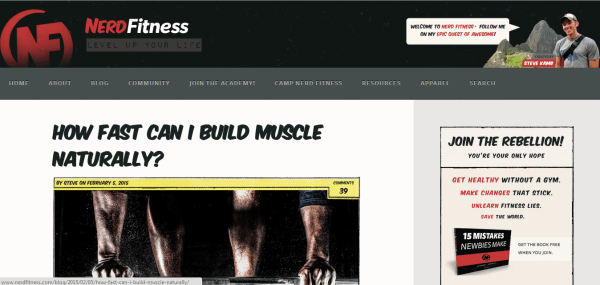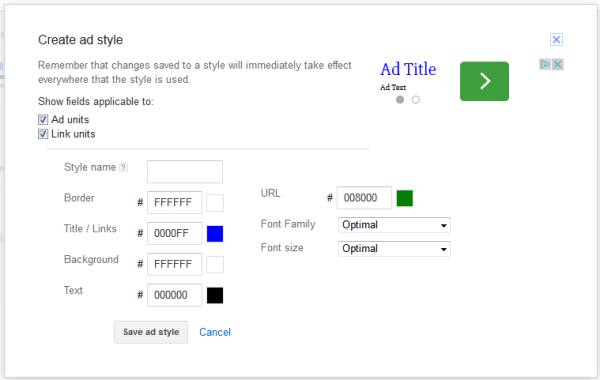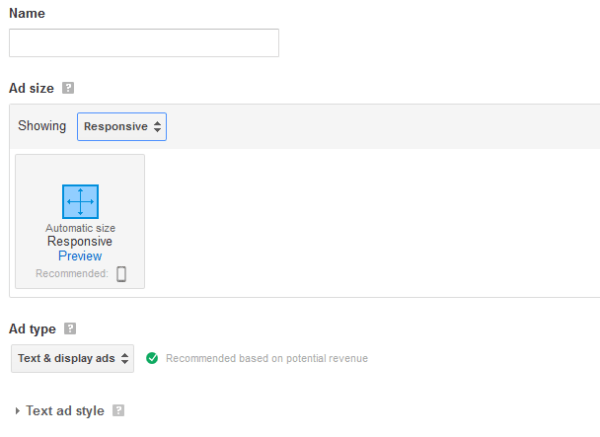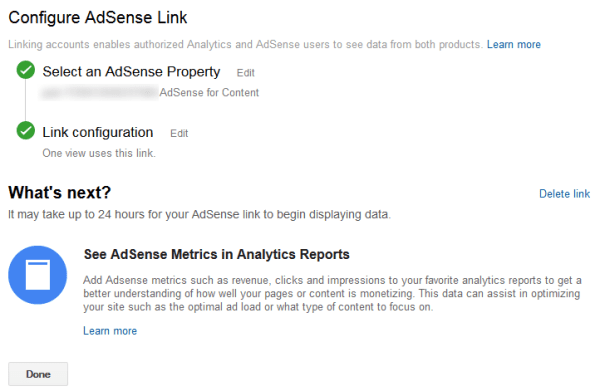11 AdSense Tips And Tricks to Maximize Your Earning Potential
Here are a few AdSense tips that will help you optimize your website for both higher revenue and an enhanced user experience.
- 1. A/B test your ad units
- 2. Use multiple ad units to maximize conversion
- 3. Limit the number of ads above the fold
- 4. Optimize the color impact of text ad units
- 5. Create and implement responsive ads
- 6. Link your AdSense and Analytics accounts
- 7. Keep your design and content user-focused
- 8. Publish high-quality content on a regular basis
- 9. Build an audience before setting up AdSense
- 10. Go easy with the blocking and filtering
- 11. Keep yourself updated
1. A/B test your ad units

Experimenting allows you to pit one variation of ad settings against another variation and select the one that performs the best. You can compare the performance of text-only ad units to ad units that have both text and display enabled, or analyze the effect of changing the color of ad text on ad performance, or determine the impact on your revenue by serving ads in the sensitive and/or general categories.
Although you need a little tech-savvy to navigate your way through the entire process of preparing your experiment, creating your experiment, monitoring your experiment, and finally choosing your winner—it’s all well worth the effort.
(Note: If you’re looking for a smarter, automated solution for this, you could try out our advanced A/B testing software, which automatically creates ad multiple variations for you and then selects the combination that performs the best.)
2. Use multiple ad units to maximize conversion

A simple way to bump up your AdSense click rate and revenue is to place ad units of more than one type (AdSense for content, link, and search) and in different sizes on your pages. This way, your users are served more ads from Google’s large ad inventory, increasing the probability that they will end up clicking on one of them.
Make sure that the best-located ad on your web page shows up first in your HTML code. This will ensure that your most visible ad real-estate is taken by ads that place the highest in the auction—increasing your revenue.
And remember to adhere to the AdSense maximum ad policy, which is up to three AdSense for content units, up to three link units, and up to two search units on each page, to avoid having your account banned.
3. Limit the number of ads above the fold

In web design terminology, “above the fold” refers to the portions of a web page that are visible without scrolling. When too many ad units are placed above the fold, users get turned off because finding the content that they came in for, gets difficult, and the tendency to exit the page increases. As a result of this, Google now penalizes such pages. Here’s an excerpt from the Google Webmaster Central blog:
“As we’ve mentioned previously, we’ve heard complaints from users that if they click on a result and it’s difficult to find the actual content, they aren’t happy with the experience. Rather than scrolling down the page past a slew of ads, users want to see content right away. So sites that don’t have much content “above-the-fold” can be affected by this change. If you click on a website and the part of the website you see first either doesn’t have a lot of visible content above-the-fold or dedicates a large fraction of the site’s initial screen real estate to ads, that’s not a very good user experience. Such sites may not rank as highly going forward.
We understand that placing ads above-the-fold is quite common for many websites; these ads often perform well and help publishers monetize online content. This algorithmic change does not affect sites that place ads above-the-fold to a normal degree, but affects sites that go much further to load the top of the page with ads to an excessive degree or that make it hard to find the actual original content on the page. This new algorithmic improvement tends to impact sites where there is only a small amount of visible content above-the-fold or relevant content is persistently pushed down by large blocks of ads.“
4. Optimize the color impact of text ad units

Experimenting with the color of text ad units is essential to increasing their visibility. An ad style that work on a light website theme may look too bright and distracting on a darker one, turning users away not only from the ad but from the web page.
For the most unobtrusive user experience, match the background and border color of the ad unit to the background of the page where the ad will be placed.
For a more distinct ad, match background and border colors to your website, but don’t match them exactly to where the ads are placed. Try out different styles and measure ad performance over time to settle on the best performing format.
5. Create and implement responsive ads

This ties into a larger point of implementing a responsive design on your website (which is something you really need to do if you’re running a website in 2015). Wikipedia explains responsive design as follows:
“Responsive web design (RWD) is an approach to web design aimed at crafting sites to provide an optimal viewing experience—easy reading and navigation with a minimum of resizing, mobile phones).”Last year, Comscore reported that mobile platforms — smartphones and tablets — combined account for 60% of total digital media time spent, up from 50% a year ago. If your website is not optimized for these devices, you’re missing out on a big opportunity to capture this audience.
So what does this have to do with AdSense, you ask? Well, AdSense plays well with responsive design, and allows you to generate codes for responsive ad units, which automatically resize themselves to offer the best viewing experience to the mobile audience. Do this now because that 60% is a number that’s only going to go north.
6. Link your AdSense and Analytics accounts

Linking your AdSense and Google Analytics accounts gives you access to AdSense metrics such as revenue, clicks, and impressions which you can add to your favorite analytics reports to get a better understanding of how well your pages or content is monetizing.
This data can assist in optimizing your site such as the optimal ad load or what type of content to focus on.
Once you’ve linked your properties, you can use insights from Analytics to refine and optimize your AdSense ad units, improving the overall performance of your website.
7. Keep your design and content user-focused
In the mad race to increase ad revenues, it’s easy to lose sight of the real goal of why your website or business exists in the first place—to provide value to users.Use a judicial mix of ads and content so that users are not overwhelmed by the former. Sometimes ads are placed haphazardly on the web page and in between content without any thought to usability or aesthetics.
Even Google says that to get the most of your account, you should first consider the user and then think about anything else. Doing it the other way around is like putting the horse before the cart, it’s never going to work.
8. Publish high-quality content on a regular basis
This really is the big one, the other points are all just tweaks in one way or another—but when it comes to AdSense earnings, content really is the king.Simply put: No traffic, no money; more traffic, more money.
But this is always easier said than done. It helps to publish content about a topic that you’re both interested in and have some level of expertise in, as people will then be more likely to view you as an influencer on your topic.
Google’s algorithm rewards websites that publish content on a regular basis with a higher ranking, and consequently, higher traffic—so make sure your publishing is more predictable than erratic.
Finally, going the extra mile to optimize your content for search engines can yield great results in terms of organic traffic, especially, in the long run.
9. Build an audience before setting up AdSense
Though it may be tempting to set up AdSense on your website right after you’ve published the first piece of content—the temptation is best avoided.Cluttering your website with ads before anybody really knows about it will likely put visitors off, and consequently, they’ll be less likely to share or link to it. This limits your ability to emerge as an authority in your niche.
Focus instead, on winning a sizable audience in terms of email subscribers, RSS readers, and monthly visitors before you start displaying ads.
10. Go easy with the blocking and filtering
Each ad that you block by URL will be one more ad that won’t be bidding for space on your website in the auction—effectively reducing the earning potential of that ad space.Furthermore, advertisers whose ads you block may decide that they don’t want to advertize with you in the future. The same thing happens when you filter out entire categories, but on a larger scale. Don’t block ads unless it’s absolutely necessary.
11. Keep yourself updated
Subscribe to the official Google Inside AdSense blog, so that you’re always up-to-date with the latest news about the platform from the creators themselves.Apart from this, the Google help center has this brilliant AdSense optimization overview that you could look at and take ideas from to get more mileage out of your AdSense account.
There’s also a free online course that Google runs, which aims help publishers earn more money from their website.
If you just follow the links mentioned here and treat them as your guide to AdSense, you’d do better than 90% of the people using the system.
What are some of the things you do to optimize your earnings from AdSense? Share in the comments and let us know.
No comments:
Post a Comment